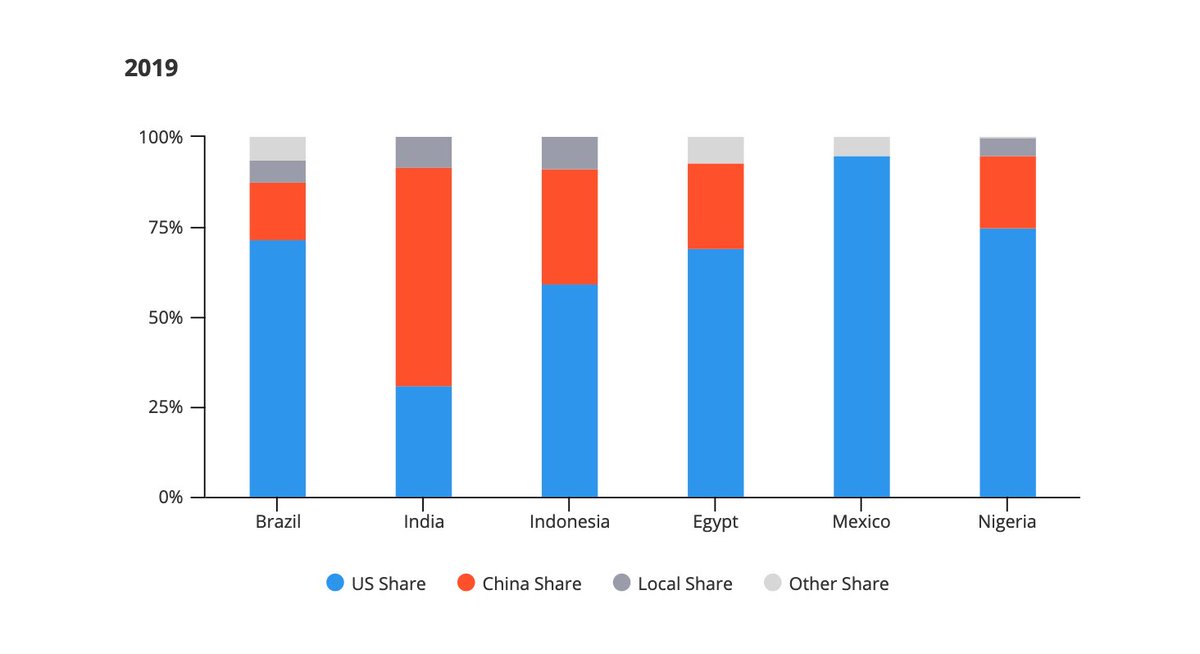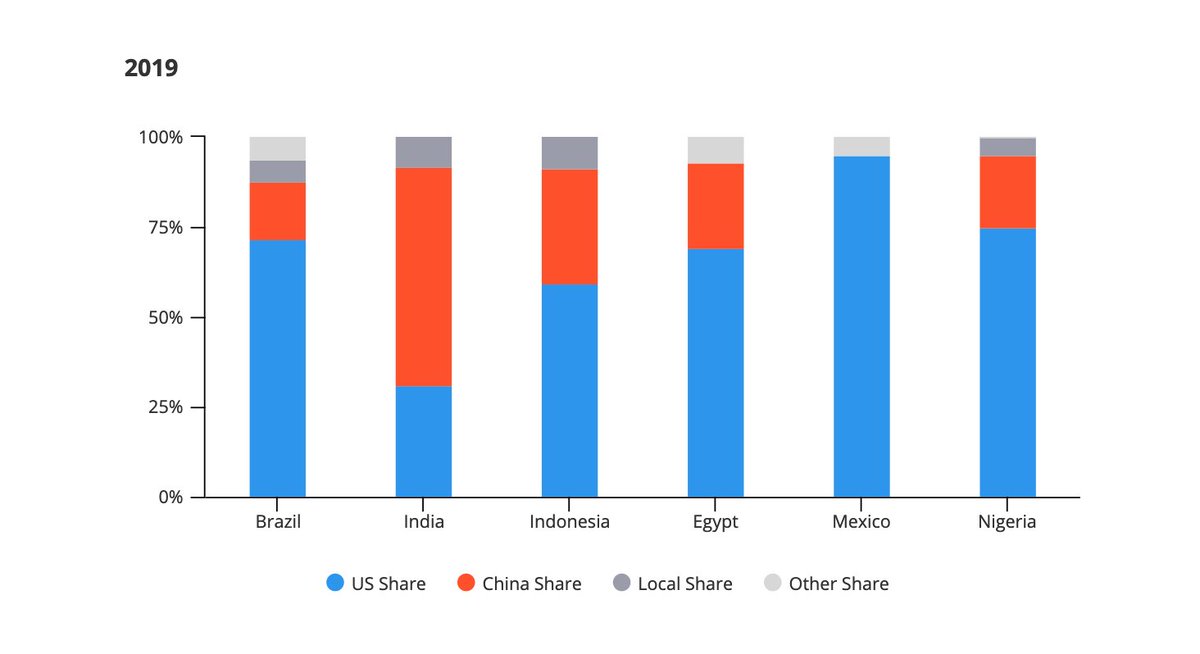
How did China go from a technological backwater to an innovation powerhouse in just 20 years?
It's a big question with big implications for 🇨🇳, 🇺🇸, and 🌍. I take a crack at answering it in my new piece for @ForeignAffairs.
🧵 1/x
foreignaffairs.com/articles/china…
It's a big question with big implications for 🇨🇳, 🇺🇸, and 🌍. I take a crack at answering it in my new piece for @ForeignAffairs.
🧵 1/x
foreignaffairs.com/articles/china…
2/x
First, what the piece is not doing:
It's not providing the be-all-end-all explanation that covers all variables. I had 2,000 words. 🤷♂️
What it is trying to do:
Provide a coherent framework for understanding the main policy drivers of China's innovation boom.
First, what the piece is not doing:
It's not providing the be-all-end-all explanation that covers all variables. I had 2,000 words. 🤷♂️
What it is trying to do:
Provide a coherent framework for understanding the main policy drivers of China's innovation boom.
3/x
Most individual Chinese innovations (e.g. the hyper addictive TikTok feed) are the product of creative thinking by hardworking technologists.
At the micro level of individual startups, tech co's or labs, that process looks pretty similar in 🇨🇳,🇺🇸,🇪🇺 and🌍.
Most individual Chinese innovations (e.g. the hyper addictive TikTok feed) are the product of creative thinking by hardworking technologists.
At the micro level of individual startups, tech co's or labs, that process looks pretty similar in 🇨🇳,🇺🇸,🇪🇺 and🌍.
4/x
But at a macro level, China's transformation into a tech powerhouse is really astounding.
Explaining the rise of China's tech ecosystem as a whole requires looking at the steps the Chinese gov took to stimulate one of the world's most dynamic innovation ecosystems.
But at a macro level, China's transformation into a tech powerhouse is really astounding.
Explaining the rise of China's tech ecosystem as a whole requires looking at the steps the Chinese gov took to stimulate one of the world's most dynamic innovation ecosystems.
5/x
🇨🇳's technological rise wasn't the result of some master plan by the Chinese government and CCP.
The process was driven by a mix of ideological paranoia, smart planning, a lot of hard work, and a bit of good luck.
🇨🇳's technological rise wasn't the result of some master plan by the Chinese government and CCP.
The process was driven by a mix of ideological paranoia, smart planning, a lot of hard work, and a bit of good luck.
6/x
I argue there were 3 key steps in building 🇨🇳's tech ecosystem:
1. Create a large, semi-protected market
2. Build connections w/ foreign tech orgs at the 🌍 cutting edge.
3. Flood China's tech ecosystem w/ critical mass of physical, financial, bureaucratic, & human resources.
I argue there were 3 key steps in building 🇨🇳's tech ecosystem:
1. Create a large, semi-protected market
2. Build connections w/ foreign tech orgs at the 🌍 cutting edge.
3. Flood China's tech ecosystem w/ critical mass of physical, financial, bureaucratic, & human resources.
7/x
The Market:
China's tech boom piggy-backed on a 30-yr economic boom. That built the disposable income+basic infrastructure making digital markets worth fighting for.
But also key was the Great Firewall, which shielded those markets so they weren't dominated by Silicon Valley
The Market:
China's tech boom piggy-backed on a 30-yr economic boom. That built the disposable income+basic infrastructure making digital markets worth fighting for.
But also key was the Great Firewall, which shielded those markets so they weren't dominated by Silicon Valley
8/x
Crucially, the Great Firewall has always been porous. Some stuff was never blocked and you could (usually) get around it if you wanted to.
That porousness let Chinese technologists stay up to date w/ 🌍 tech trends, but prevented foreign products from dominating 🇨🇳 market.
Crucially, the Great Firewall has always been porous. Some stuff was never blocked and you could (usually) get around it if you wanted to.
That porousness let Chinese technologists stay up to date w/ 🌍 tech trends, but prevented foreign products from dominating 🇨🇳 market.
9/x
The Great Firewall also ended up serving another purpose: it turned the Chinese gov into the gatekeeper of the world's largest market.
That would prove to be an important part of the next step in the rise of China's tech ecosystem...
The Great Firewall also ended up serving another purpose: it turned the Chinese gov into the gatekeeper of the world's largest market.
That would prove to be an important part of the next step in the rise of China's tech ecosystem...
10/x
Step 2: Build close connections with foreign science & tech orgs (universities, companies, labs) working at the global cutting edge.
This is the step that most of 🇺🇸 policy has focused on. I argue those ties were impt for China's rise, but not in the way most people think.
Step 2: Build close connections with foreign science & tech orgs (universities, companies, labs) working at the global cutting edge.
This is the step that most of 🇺🇸 policy has focused on. I argue those ties were impt for China's rise, but not in the way most people think.
11/x
Traditional explanations of China's rise in tech focus heavily on IP theft, and they see 🇨🇳🇺🇸 ties as a vector for that theft.
IP theft has been very real & it cost lots of companies money. But it doesn't come close to explaining the growth of China's innovation ecosystem.
Traditional explanations of China's rise in tech focus heavily on IP theft, and they see 🇨🇳🇺🇸 ties as a vector for that theft.
IP theft has been very real & it cost lots of companies money. But it doesn't come close to explaining the growth of China's innovation ecosystem.
12/x
The biggest impact of transpacific ties ties didn't come from stealing. It came from learning.
Exposure to Silicon Valley gave Chinese technologists the intellectual fodder (ideas, best practices, operating models etc.) that helped ignite the growth of it's tech ecosystem.
The biggest impact of transpacific ties ties didn't come from stealing. It came from learning.
Exposure to Silicon Valley gave Chinese technologists the intellectual fodder (ideas, best practices, operating models etc.) that helped ignite the growth of it's tech ecosystem.
13/x
I witnessed that that transpacific flow of ideas a bunch as a reporter.
I wrote about that here: huffpost.com/entry/china-sm…
Here's a great piece by @paulmozur: nytimes.com/2016/12/04/tec…
And in my book (that you should get!): amazon.com/Transpacific-E…
I witnessed that that transpacific flow of ideas a bunch as a reporter.
I wrote about that here: huffpost.com/entry/china-sm…
Here's a great piece by @paulmozur: nytimes.com/2016/12/04/tec…
And in my book (that you should get!): amazon.com/Transpacific-E…
14/x
Most of these transpacific tech ties were bottom-up, driven by technologists, investors and businesses in both countries who wanted to work together.
But the 🇨🇳 gov also also played the role of chaperone. It dangled the carrot of market access & pushed for more interaction.
Most of these transpacific tech ties were bottom-up, driven by technologists, investors and businesses in both countries who wanted to work together.
But the 🇨🇳 gov also also played the role of chaperone. It dangled the carrot of market access & pushed for more interaction.
Wheww these threads take a while to write and they really take it out of you (or me, at least). Feel free to click the link and read ahead!
foreignaffairs.com/articles/china…
foreignaffairs.com/articles/china…
17/x
After building the market & international connections, China got to the last (and imho most interesting) step in fostering innovation:
Throw a ton of resources at stuff.
When China identifies a promising new industry or technology, it often throws the kitchen sink at it.
After building the market & international connections, China got to the last (and imho most interesting) step in fostering innovation:
Throw a ton of resources at stuff.
When China identifies a promising new industry or technology, it often throws the kitchen sink at it.
18/x
A great illustration of throw-the-kitchen-sink approach came in the aftermath of 🇨🇳's 2017 national AI plan.
China AI industry had already been building momentum for years, but when the Chinese gov released it's AI plan it threw a ton of fuel on that fire.
A great illustration of throw-the-kitchen-sink approach came in the aftermath of 🇨🇳's 2017 national AI plan.
China AI industry had already been building momentum for years, but when the Chinese gov released it's AI plan it threw a ton of fuel on that fire.
19/x
China's AI plan wasn't a step-by-step guide for how to lead the 🌏 in AI.
It was a signal from CCP leaders to China's massive bureaucracy (and private co's) that AI was impt, and they would be rewarded (or at least not punished) for trying to advance that any way they could
China's AI plan wasn't a step-by-step guide for how to lead the 🌏 in AI.
It was a signal from CCP leaders to China's massive bureaucracy (and private co's) that AI was impt, and they would be rewarded (or at least not punished) for trying to advance that any way they could
20/x
The result was an explosion in activity as all kinds of Chinese officials rushed to do something, anything w/ AI.
- subsidize AI startups
- found "AI institutes" at universities
- create pilot programs for autonomous trucks
- buy tons & tons of surveillance products
The result was an explosion in activity as all kinds of Chinese officials rushed to do something, anything w/ AI.
- subsidize AI startups
- found "AI institutes" at universities
- create pilot programs for autonomous trucks
- buy tons & tons of surveillance products
21/x
I wrote about that process for @MacroPoloChina here: macropolo.org/analysis/how-c…
And made a small interactive map of it here: macropolo.org/digital-projec…
The process I'm describing maps closely onto @yuenyuenang's great concept of "directed improvisation." theasiadialogue.com/2017/06/15/dir…
I wrote about that process for @MacroPoloChina here: macropolo.org/analysis/how-c…
And made a small interactive map of it here: macropolo.org/digital-projec…
The process I'm describing maps closely onto @yuenyuenang's great concept of "directed improvisation." theasiadialogue.com/2017/06/15/dir…
22/x
From a 🇺🇸 perspective, activity from China's AI plan was wasteful. Hyped projects died, equipment never got used, and lots of it didn't have any actual "AI" in it.
But it gave a lot of scientists & entrepreneurs runway to experiment & turbocharged AI adoption across 🇨🇳.
From a 🇺🇸 perspective, activity from China's AI plan was wasteful. Hyped projects died, equipment never got used, and lots of it didn't have any actual "AI" in it.
But it gave a lot of scientists & entrepreneurs runway to experiment & turbocharged AI adoption across 🇨🇳.
23/x
Alright to recap: China's rise as an innovative powerhouse over last 20 yrs has been remarkable, and depended on 3 steps.
1. Large+semi-protected market
2. Ties to foreign tech orgs at global cutting edge
3. Flooding China's ecosystem w/ tons of resources
Alright to recap: China's rise as an innovative powerhouse over last 20 yrs has been remarkable, and depended on 3 steps.
1. Large+semi-protected market
2. Ties to foreign tech orgs at global cutting edge
3. Flooding China's ecosystem w/ tons of resources
24/x
Can/should the 🇺🇸 adopt 🇨🇳's model for innovation?
Not directly. Our systems are wildly different & lots of it won't work here.
Still, we can learn one thing: spurring innovation is a super messy process, but you can't let that messiness stop you from trying stuff.
Can/should the 🇺🇸 adopt 🇨🇳's model for innovation?
Not directly. Our systems are wildly different & lots of it won't work here.
Still, we can learn one thing: spurring innovation is a super messy process, but you can't let that messiness stop you from trying stuff.
25/x There's lots more in the piece so give it a read: foreignaffairs.com/articles/china…
If you're interested in this here's a small sample of people to follow @ruima @jjding99 @EBKania @hlntnr @gwbstr @China_Digital @JonKBateman @paulmozur @adschina @shenlulushen @_KarenHao Shazeda Ahmed
If you're interested in this here's a small sample of people to follow @ruima @jjding99 @EBKania @hlntnr @gwbstr @China_Digital @JonKBateman @paulmozur @adschina @shenlulushen @_KarenHao Shazeda Ahmed
26/26
Finally, big shout-out to the people who helped support this work and make this piece happen. @DouglasLFarrar & all of @CarnegieEndow comms, @katherinezoepf at Foreign Affairs, and @EvanFeigenbaum + the #CarnegieAsia team.
Thanks for reading! /end
Finally, big shout-out to the people who helped support this work and make this piece happen. @DouglasLFarrar & all of @CarnegieEndow comms, @katherinezoepf at Foreign Affairs, and @EvanFeigenbaum + the #CarnegieAsia team.
Thanks for reading! /end
• • •
Missing some Tweet in this thread? You can try to
force a refresh











